Arto's Blog
Sabai dii Pi Mai Lao
Posted: 2013-04-30 14:00:28, Categories: Travel, Cycling, Laos, 903 words (permalink)
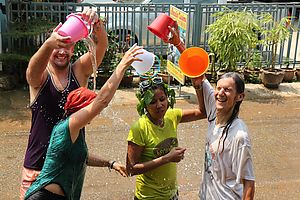 In Mid-April, in the town of Vang Vieng, we attended the cheerful
celebration of Pi Mai Lao, the Lao New Year. Hundreds of people poured
small buckets of water over us, wishing us Happy New Year. We joined
the teams by the roadside and did our own share of watering people
passing by. Beer Lao was generously offered to friends and strangers
alike, music was played from large loudspeakers all around the town
and everybody had a great time.
In Mid-April, in the town of Vang Vieng, we attended the cheerful
celebration of Pi Mai Lao, the Lao New Year. Hundreds of people poured
small buckets of water over us, wishing us Happy New Year. We joined
the teams by the roadside and did our own share of watering people
passing by. Beer Lao was generously offered to friends and strangers
alike, music was played from large loudspeakers all around the town
and everybody had a great time.
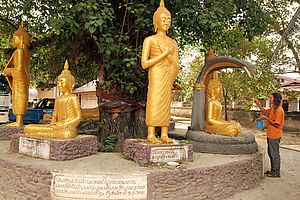 Traditionally, people prepare flowers and perfumed water which is
taken to temples and sprinkled over buddha statues. Some of the
water is carried back home and gently poured on relatives and
friends, to purify them and give a good start for the New Year. This
all still happens and the Buddhist New Year is a beautiful time to
visit a temple, stop for a prayer and do the ceremony following the
locals. We also did.
Traditionally, people prepare flowers and perfumed water which is
taken to temples and sprinkled over buddha statues. Some of the
water is carried back home and gently poured on relatives and
friends, to purify them and give a good start for the New Year. This
all still happens and the Buddhist New Year is a beautiful time to
visit a temple, stop for a prayer and do the ceremony following the
locals. We also did.
 A newer habit is to stand in small groups by the roadside, armed
with a garden hose, buckets and water guns, and to pour or throw
water on everyone who passes by. People in Laos usually drive small
motorcycles, which makes them good targets. Even the majority of
cars are pickups or half-open trucks, with people sitting in the
back unprotected from water. If someone doesn't like to get wet,
it's simply best to stay indoors. Most people don't mind, as it's
part of the New Year and the sun dries everything quickly
anyway.
A newer habit is to stand in small groups by the roadside, armed
with a garden hose, buckets and water guns, and to pour or throw
water on everyone who passes by. People in Laos usually drive small
motorcycles, which makes them good targets. Even the majority of
cars are pickups or half-open trucks, with people sitting in the
back unprotected from water. If someone doesn't like to get wet,
it's simply best to stay indoors. Most people don't mind, as it's
part of the New Year and the sun dries everything quickly
anyway.
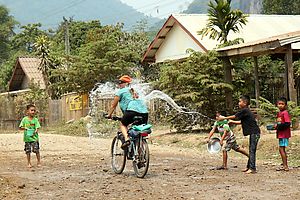 In the gentle and polite version of the New Year greeting, people
first wave the driver to stop. Then they pour a small amount of
water on the neck so that it runs down along the back, accompanied
with a cheerful wish of "Sabai dii Pi Mai", "Souksan van Pi Mai" or
"Suk dii Pi Mai", which translate to "Happy New Year" or "Good
luck for the New Year". If someone has a bag or something else which
shouldn't get wet, it can be lifted up so that no damage is done.
Especially elderly people were mostly greeted this way.
In the gentle and polite version of the New Year greeting, people
first wave the driver to stop. Then they pour a small amount of
water on the neck so that it runs down along the back, accompanied
with a cheerful wish of "Sabai dii Pi Mai", "Souksan van Pi Mai" or
"Suk dii Pi Mai", which translate to "Happy New Year" or "Good
luck for the New Year". If someone has a bag or something else which
shouldn't get wet, it can be lifted up so that no damage is done.
Especially elderly people were mostly greeted this way.
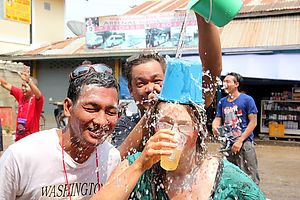 We as young foreigners on bicycles were naturally fair targets for
all variants of the game. Often we got several buckets of water
poured over us, followed by a glass of beer to drink, which we were
expected to finish before being allowed to ride forwards. Children
sprayed us with water guns, sometimes with water coloured in yellow,
green or red. A couple of times we also got white talcum powder
sprinkled on our heads. It was fun to ride around to see and feel
the party.
We as young foreigners on bicycles were naturally fair targets for
all variants of the game. Often we got several buckets of water
poured over us, followed by a glass of beer to drink, which we were
expected to finish before being allowed to ride forwards. Children
sprayed us with water guns, sometimes with water coloured in yellow,
green or red. A couple of times we also got white talcum powder
sprinkled on our heads. It was fun to ride around to see and feel
the party.
 When we wanted to play with water ourselves, we simply stopped at
one of the groups of locals by the roadside. They welcomed us
enthusiastically with an extra dose of water to make sure we'd be
wet enough, we got buckets, a bit of colour to the face and a glass
of beer, and were ready to join the team. So we also poured and
threw water on passers-by, on each other and on everybody around,
wished all Happy New Year and danced to the music. As for the beer,
we tried our best to drink a little bit with everyone while
avoiding to get too drunk. I'd say it worked out quite well.
When we wanted to play with water ourselves, we simply stopped at
one of the groups of locals by the roadside. They welcomed us
enthusiastically with an extra dose of water to make sure we'd be
wet enough, we got buckets, a bit of colour to the face and a glass
of beer, and were ready to join the team. So we also poured and
threw water on passers-by, on each other and on everybody around,
wished all Happy New Year and danced to the music. As for the beer,
we tried our best to drink a little bit with everyone while
avoiding to get too drunk. I'd say it worked out quite well.
 There were also many groups driving around in pickup trucks,
equipped with barrels full of water, buckets, water guns and
sometimes small water bombs. They engaged in water fights with other
pickups and with the teams by the roadside. Even a bigger truck with
a several thousand liter tank of water drove around spraying water
from a big hose. We heard that spraying water directly from garden
hoses and coloured water are actually forbidden, but nobody seemed
to mind. These were joyful water fights where everybody wins.
There were also many groups driving around in pickup trucks,
equipped with barrels full of water, buckets, water guns and
sometimes small water bombs. They engaged in water fights with other
pickups and with the teams by the roadside. Even a bigger truck with
a several thousand liter tank of water drove around spraying water
from a big hose. We heard that spraying water directly from garden
hoses and coloured water are actually forbidden, but nobody seemed
to mind. These were joyful water fights where everybody wins.
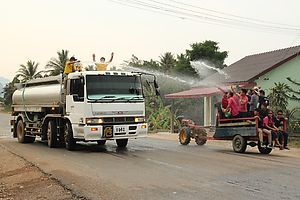 Officially the celebrations lasted for three days, from 14th until
16th of April. Some people started a day or two earlier, but 16th
was really the last day with water play. Eating, drinking and
dancing continued a day or two more, extending the party to a full
week. Most of the activity happened during daytime, from about 10 am
until 5 or 6 pm. In the evening nobody was throwing water any more:
it was time to sit down, eat and drink with friends. Music was
played at all times. In Laos nobody complains about loud music even
at night, especially not during New Year. Still, after 9 or 10 pm
most people went to sleep and it was already relatively quiet.
Officially the celebrations lasted for three days, from 14th until
16th of April. Some people started a day or two earlier, but 16th
was really the last day with water play. Eating, drinking and
dancing continued a day or two more, extending the party to a full
week. Most of the activity happened during daytime, from about 10 am
until 5 or 6 pm. In the evening nobody was throwing water any more:
it was time to sit down, eat and drink with friends. Music was
played at all times. In Laos nobody complains about loud music even
at night, especially not during New Year. Still, after 9 or 10 pm
most people went to sleep and it was already relatively quiet.
 We were impressed by the openness of people welcoming us, even
though we didn't know more than a couple of words of Lao and the
English abilities of our hosts were often on the same level. In
Germany or Finland strangers passing by would not be so easily
invited to join and warmly welcomed to a party. The attitude of the
Lao people was that shared fun is more fun, and everybody is
welcome. That's something we can also try to learn from them.
We were impressed by the openness of people welcoming us, even
though we didn't know more than a couple of words of Lao and the
English abilities of our hosts were often on the same level. In
Germany or Finland strangers passing by would not be so easily
invited to join and warmly welcomed to a party. The attitude of the
Lao people was that shared fun is more fun, and everybody is
welcome. That's something we can also try to learn from them.
Overall, the Lao New Year was one the funniest festivals we've ever been to. People were happy, playful and relaxed, having a good party mood. The water play was sometimes wild, but not rough. If we happen to be in Laos or Thailand (where the festival is called Songkran) in the future at the same time of the year, we'll certainly be on the streets again.
Up and down the mountains in Northern Thailand and Laos
Posted: 2013-04-09 18:58:09, Categories: Travel, Thailand, Cycling, Laos, 1205 words (permalink)
 Our bicycle tour continued to Chiang Mai, the largest city in Northern
Thailand, and further North-East towards Laos. The landscape became
more mountainous and the roads climbed up and down with numerous
sharp curves. The temperatures were pleasantly a bit cooler than in
Central Thailand, due to the higher altitude and the surrounding
hills and mountains. Especially during the nights the temperatures
dropped, making blankets more useful than air condition.
Our bicycle tour continued to Chiang Mai, the largest city in Northern
Thailand, and further North-East towards Laos. The landscape became
more mountainous and the roads climbed up and down with numerous
sharp curves. The temperatures were pleasantly a bit cooler than in
Central Thailand, due to the higher altitude and the surrounding
hills and mountains. Especially during the nights the temperatures
dropped, making blankets more useful than air condition.
About 60 km north-east of Chiang Mai we came to the Bua Tong waterfall. We had seen several beautiful waterfalls a few days earlier in the Doi Inthanon national park, but Bua Tong totally surprised us. The water flowed down the cliffs in relatively small steps, which had a sandpaper like surface with a good grip. Children and adults alike were climbing up and down the falls, playing with the water. We naturally joined the party: a refreshing and fun experience!
 In Chiang Khong we crossed the border over the Mekong river to Huay
Xai, Laos. There we took a break from cycling and joined the Gibbon
Experience, a one and a half day trip to the jungle with
ziplines. Wearing a climbing harness and hanging from a metal wire,
one glides through the forest and above the treetops. It was a
series of exciting rides and great views to the nature at the same
time, with the longest ziplines being almost a kilometer long. The
night was spent in a treehouse, swinging gently in the wind several
dozen meters above the ground. We didn't see any gibbons, but
enjoyed the forest which had some magnificent giant trees. According
to the Gibbon Experience
website, the income of the activity is funding the protection of
the forest. Without deeper knowledge it's hard to say how large a
share truly goes to preservation, and how much building the ziplines
and riding them disturbs the nature, but I do believe it's a more
sustainable business model than logging and burning the forest to
fields.
In Chiang Khong we crossed the border over the Mekong river to Huay
Xai, Laos. There we took a break from cycling and joined the Gibbon
Experience, a one and a half day trip to the jungle with
ziplines. Wearing a climbing harness and hanging from a metal wire,
one glides through the forest and above the treetops. It was a
series of exciting rides and great views to the nature at the same
time, with the longest ziplines being almost a kilometer long. The
night was spent in a treehouse, swinging gently in the wind several
dozen meters above the ground. We didn't see any gibbons, but
enjoyed the forest which had some magnificent giant trees. According
to the Gibbon Experience
website, the income of the activity is funding the protection of
the forest. Without deeper knowledge it's hard to say how large a
share truly goes to preservation, and how much building the ziplines
and riding them disturbs the nature, but I do believe it's a more
sustainable business model than logging and burning the forest to
fields.
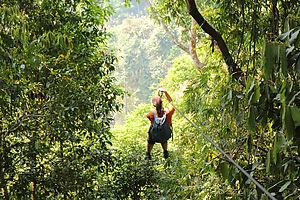 From Huay Xai we continued further east across Northern Laos. The
Lao road network is much less dense than in Thailand, so we couldn't
easily plan a route on secondary roads. Fortunately the main road
number 3 towards Luang Namtha was far from a busy highway, rather
resembling the countryside roads we had been cycling in
Thailand. The population density of Laos is less than a fifth of
that in Thailand, and only few people have cars. Heavily loaded old
trucks and minibuses occasionally unfreshened the air with thick
black clouds of exhaust while passing us, but the traffic density
was low enough not to bother us too much.
From Huay Xai we continued further east across Northern Laos. The
Lao road network is much less dense than in Thailand, so we couldn't
easily plan a route on secondary roads. Fortunately the main road
number 3 towards Luang Namtha was far from a busy highway, rather
resembling the countryside roads we had been cycling in
Thailand. The population density of Laos is less than a fifth of
that in Thailand, and only few people have cars. Heavily loaded old
trucks and minibuses occasionally unfreshened the air with thick
black clouds of exhaust while passing us, but the traffic density
was low enough not to bother us too much.
The road continued to go up and down large hills, with beautiful views down to the valleys on higher passes. The surface was paved and in good condition, a pleasure to ride. The land was partly covered by forest and partly deforested, with mainly Chinese and Vietnamese buying the wood. We saw many small rivers, which were generally cleaner than in Thailand, probably due to almost complete lack of any industry in the area.
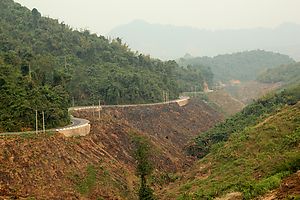 Both Lao and Thai people have a habit to burn patches of land,
often to prepare a field but sometimes with no apparent
purpose. Most of the burning happens between February and April,
which in combination of the long dry period makes the air misty and
dusty, like constantly being inside a thin cloud. It has not been
difficult to breathe but we have certainly felt the difference from
fresh and clear mountain air. We've also missed the blue sky, which
will only appear again when the rainy season begins in May or
June.
Both Lao and Thai people have a habit to burn patches of land,
often to prepare a field but sometimes with no apparent
purpose. Most of the burning happens between February and April,
which in combination of the long dry period makes the air misty and
dusty, like constantly being inside a thin cloud. It has not been
difficult to breathe but we have certainly felt the difference from
fresh and clear mountain air. We've also missed the blue sky, which
will only appear again when the rainy season begins in May or
June.
Roughly every five kilometers the road went through a small village. Children were happily waving and shouting "Hello" or "Sabaidee", often running to the roadside to meet us. They didn't have much but were laughing, playing and seemingly enjoying life. We rarely heard a child crying or anybody shouting in an angry voice. Adults were a bit more reserved but many still greeted us, staring, smiling and wondering why on earth were we pedaling all those uphills by bicycle when also motorcycles had been invented.
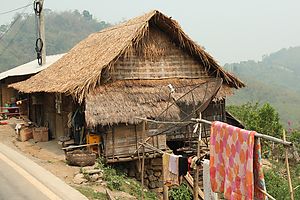 Most of the houses in villages were modest bamboo huts, probably
similar than they've been for hundreds of years, except being
nowadays equipped with electricity, tv and a satellite dish.
Cooking was still commonly done on fire and washing at the village
well. Here and there between the huts appeared fancier newer houses
built from concrete, especially in villages located near bigger
towns. Almost every village also had an elementary school, often
built with the support of some charity organization. That was the
situation in villages next to the main road. Rural villages tucked
between the mountains, many of them accessible only via narrow dirt
tracks, are apparently still less developed.
Most of the houses in villages were modest bamboo huts, probably
similar than they've been for hundreds of years, except being
nowadays equipped with electricity, tv and a satellite dish.
Cooking was still commonly done on fire and washing at the village
well. Here and there between the huts appeared fancier newer houses
built from concrete, especially in villages located near bigger
towns. Almost every village also had an elementary school, often
built with the support of some charity organization. That was the
situation in villages next to the main road. Rural villages tucked
between the mountains, many of them accessible only via narrow dirt
tracks, are apparently still less developed.
We cycled about 400 km from west to east via Luang Namtha and Oudomxay until Muang Khoua, a small town near the Vietnamese border. From there we took a two-day boat ride south on the Nam Ou river, finally joining the Mekong and arriving in Luang Prabang. The ride was very scenic, villages by the riverside only accessible by boat, fishermen, water buffaloes, small rapids, rock formations, sandy beaches and majestic mountains. Between the two days spent in the boat we stayed for two nights in Muang Ngoi, a riverside village transformed into a backpacker hangout as a result of all the boats stopping there. Despite the tourist crowds it was still a quiet and atmospheric place, having no cars and electricity only between 6 and 10 pm produced by a generator. That said, a new electricity line was just being installed and a road being built, which will certainly make a big change.
 In Luang Prabang we went to see some of the well-known sights. The
old and beautiful Xiengthong temple and the Kuang Xi waterfalls 30
km outside the city with idyllic turquoise pools were really worth a
visit. After that we headed again out to the countryside and started
cycling towards Phonsavan. The road was even a bit more mountainous
than earlier parts of our route, making some of the days quite
exhausting. Villages seemed to be a bit wealthier than in the
north, but ironically the first time children came to beg for candy
and money. It didn't happen often, but a few times during our ride
through the region.
In Luang Prabang we went to see some of the well-known sights. The
old and beautiful Xiengthong temple and the Kuang Xi waterfalls 30
km outside the city with idyllic turquoise pools were really worth a
visit. After that we headed again out to the countryside and started
cycling towards Phonsavan. The road was even a bit more mountainous
than earlier parts of our route, making some of the days quite
exhausting. Villages seemed to be a bit wealthier than in the
north, but ironically the first time children came to beg for candy
and money. It didn't happen often, but a few times during our ride
through the region.
Overall the pace of life in Laos is slow, slower than in Thailand. Selection in shops and on the markets is smaller, there is not much effort in arranging things attractively on the shelves and never a push to buy anything. Restaurants are serving more basic food, which however is usually tasty and not too spicy. Nobody seems to be in a hurry to go somewhere. This helps also the traveller to adopt a more relaxed and simple lifestyle. We will see how the atmosphere will change in a few days, during the celebration of Pi Mai, the Lao New Year. In addition to old traditions of cleaning homes and paying respect to the gods, the festivities include some wild partying and water throwing. In these temperatures being sprayed with water is a pleasure, so we're looking forward to joining and getting wet.

Copyright Arto Teräs <ajt@iki.fi>, licensed under the Creative Commons Attribution-Share Alike 3.0 Unported License. (Unless otherwise mentioned in individual photos or other content.)